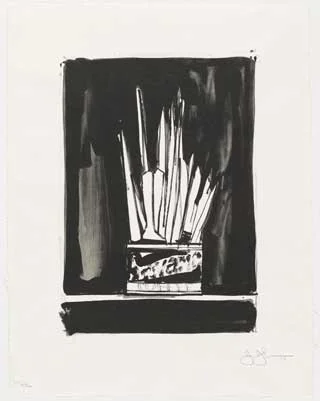Savarin 4 (Oval)
(ULAE 194), 1978
26 x 20 1/2 inches
edition: 42 with 5 AP's & 3 PP's
signed and dated lower right and numbered lower left, in pencil
ULAE Blindstamp bottom left
published by ULAE, 1978, West Islip, New York
printed by Bill Goldston, James V. Smith, Keith Brintzenhofe
© 2024 Jasper Johns / Licensed by VAGA at Artists Rights Society (ARS), NY
Literature
Judith Goldman, Jasper Johns Prints 1977-1981, Thomas Segal Gallery, Boston, MA, 1981, n.p., Segal 8, another impression reproduced full page black and white.
Shigeo Chiba, Jasper Johns Prints Exhibition 1960–1989, Tokyo, 1990, Japan Art and Culture Association/Kokusai Geijutsu Bunka Shinkokai, n.p., plate 66, another impression reproduced.
Michel Butor, Kathleen Slavin, Jasper Johns Gravures Dessins 1960-1991, Foundation Vincent Van Gogh, 1992, no. 64, pg. 114, another impression reproduced in full-page color.
Richard Field, The Prints of Jasper Johns 1960-1993: A Catalogue Raisonne, ULAE, New York, 1994, Catalogue Reference ULAE 194, n.p., another impression reproduced in full-page color.
Susan Lorence, Technique and Collaboration in the Prints of Jasper Johns, Castelli Gallery, New York, 1996, Catalogue Reference 26, n.p., another impression reproduced in black and white
Exhibited
The Museum of Modern Art, New York, Recent Acquisitions: American Prints, Nov 16, 1978–Feb 20, 1979, another impression exhibited.
The Seibu Museum of Art, Tokyo, Prints Exhibition 1960–1989, Traveled to The Seibu Department Store, Isetan Museum of Art, Tokyo, April 26th—May 15th, 1990, Isetan Department Store, Niigata, June 7-19, 1990, Isetan Department Store, Urawa, July 18-24, 1990, Isetan Department Store, Matsudo, August 9—August 14, 1990, Isetan Department Store, Shizuoka, August 23—August 28, 1990, another impression exhibited.
The Atkinson, Southport, Warhol to Walker: American prints from pop art to today, January 13, 2018–March 10, 2018, other impression exhibited.
Foundation Vincent Van Gogh, Arles, Jasper Johns Prints and Drawings from the Castelli collection, July 4-September 30, 1992, another impression exhibited.
Carnegie Museum of Art, Pittsburgh, An Art of Changes: Jasper Johns Prints, 1960–2018, October 12–January 20, 2020, another impression exhibited; exhibition traveled to these venues:
Walker Art Center, Minneapolis, February 16, 2020–January 3, 2021
Tampa Art Museum, Florida, April 28–September 5, 2021
Grand Rapids Art Museum, Michigan, October 2–January 9, 2022
Parrish Art Museum, Water Mill, New York, April 23–July 10, 2022
Whitney Museum of American Art, New York, Jasper Johns Mind/Mirror, September 29, 2021 - February 13, 2022, another impression exhibited.
Selected Museum Collections
Walker Art Center, Minneapolis
Museum of Modern Art, New York
The Broad Museum, Los Angeles
Additional Photos
Jasper Johns made a life-size painted bronzed sculpture based on a Savarin coffee can that he used to hold paintbrushes in his studio. The Savarin can, which may be interpreted as a surrogate for Johns, debuted in his work as a painted bronze sculpture in 1960. He returned to the image in mid-1970's with a series of prints exploring variations on the Savarin Can.








